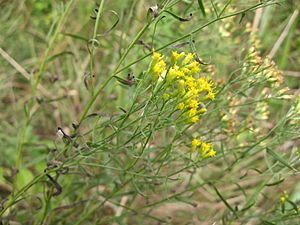Euthamia gymnospermoides facts for kids
Quick facts for kids Euthamia gymnospermoides |
|
|---|---|
 |
|
| Scientific classification | |
| Genus: |
Euthamia
|
| Species: |
gymnospermoides
|
| Synonyms | |
|
Synonymy
Euthamia camporum Greene
Euthamia glutinosa Rydb. Euthamia pulverulenta Greene Solidago camporum (Greene) A.Nelson Solidago chrysothamnoides (Greene) Bush Solidago gymnospermoides (Greene) Fernald Solidago media (Greene) Bush Solidago perglabra Friesner Solidago remota (Greene) Friesner Solidago texensis Friesner |
|
The Great Plains goldentop or Texas goldentop (scientific name: Euthamia gymnospermoides) is a type of plant. It belongs to the composite family, which is a large group of flowering plants. This family is also known as the daisy or sunflower family.
This plant is mostly found in the Great Plains and Great Lakes Region of North America. It likes to grow in prairies and areas with sandy soil.
Contents
Great Plains Goldentop
The Great Plains goldentop is a perennial plant. This means it lives for more than two years. It grows back each year from its roots.
What is a Goldentop?
Goldentop plants are known for their bright yellow flowers. They often grow in sunny, open areas. The Great Plains goldentop is one of several species in the Euthamia genus. These plants are sometimes confused with goldenrods.
Where Does it Grow?
This plant is native to a wide area in the central United States and parts of Canada. It thrives in the open grasslands of the Great Plains. You can also find it near the Great Lakes. It prefers places with lots of sun and well-drained soil. This includes prairies, savannas, and sandy fields.
How to Spot It
The Great Plains goldentop produces many small, yellow flowers. These flowers grow in clusters at the top of the plant's stems. They usually bloom in late summer. This plant can grow quite tall, often reaching several feet in height.
One way to tell it apart from a similar plant, Euthamia graminifolia, is by its leaves. The Great Plains goldentop has only one main vein on each leaf. Its flower heads are also larger. This helps botanists identify the plant correctly.
Life Cycle of the Goldentop
As a perennial, the Great Plains goldentop grows from its roots each spring. It spends the spring and early summer growing its stems and leaves. In late summer, it produces its bright yellow flowers. These flowers attract pollinators like bees and butterflies. After flowering, the plant produces seeds. These seeds help the plant spread and grow new plants. The plant's roots survive the winter, ready to grow again next spring.

